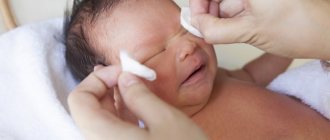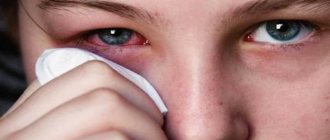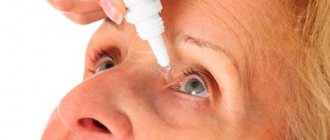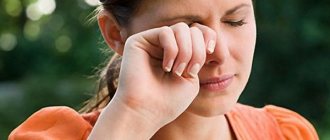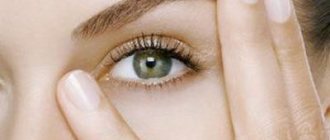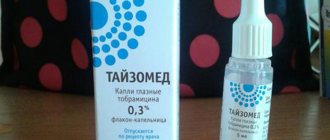Causes of teary eyes
In order for the ophthalmologist to correctly select medications for the patient, he needs to identify the cause of increased lacrimation. The most common of them in medical practice include:
- Colds and inflammation of the paranasal sinuses. With this disease, the paranasal sinuses are blocked because the nasal septum swells. This puts increased pressure on the tear glands of the eyes.
- Irritants from the external environment. These may include some natural phenomena: excessively bright lighting, strong winds, snow or rain. In such conditions, tear production works as a protective function.
- Tired eyes. Tearfulness often occurs in people who place a lot of strain on the visual system. For example, they spend a long time looking at a computer monitor, reading, or staying awake for a long time.
- Allergic reactions. In this case, tearfulness can be observed under certain conditions, that is, the presence of an irritant, or be characterized by seasonality.
- Infectious eye diseases. If the patient has an infectious pathology, tearfulness may first appear in one eye and then move to the second.
- Violation of hygiene rules.
- Incorrectly selected means of contact vision correction.
Possible reasons
The eyes of the elderly become watery (the causes and treatment depend on many individual factors), most often due to natural age-related changes, so patients do not pay attention to the discomfort and do not seek the help of specialists.
However, lacrimation can become a symptom of a serious disease, which, if left untreated, can lead to serious complications. The main causes of lacrimation include:
Age-related changes
The position of individual parts of the eye changes with age. With age, a person may change the position of the lacrimal nipple, tear ducts and decrease the tone of the lower eyelid, which is why the eyelashes begin to come into contact with the mucous membrane of the eye.
Their change and curvature affects not only visual acuity, but also the processes of fluid secretion. All this provokes increased lacrimation, which occurs in older people in 20% of cases and does not require mandatory treatment.
Dry eye syndrome
Dry eye syndrome involves constant excessive dryness of most of the surface of the eyeball, which is associated with a violation of natural metabolic processes.
In this case, the body develops a compensatory mechanism that releases an increased amount of fluid to restore balance, which simply flows out of the eye in the form of tears.
Increased sensitivity
In older people, the eyes become watery due to a sharp increase in sensitivity to certain irritants, which in some cases creates discomfort and requires treatment. With severe overwork, bright sun, strong wind, the eyes can no longer cope with the surrounding conditions due to decreased muscle tone and changes in the circulatory system inside the eye.
The same applies to situations where older people wear contact lenses or incorrectly selected glasses for a long time. In this case, lacrimation is a natural reaction of the body to irritating factors. Increased sensitivity of the eyes does not require treatment and can be easily eliminated by wearing sunglasses or dosing loads.
Viral infections of various types
Certain viral colds and diseases of the respiratory system provoke temporary increased lacrimation. The mucous membranes of the nose, pharynx and larynx are closely connected with the tear ducts.
If the eyes of older people are watery, this may be due to a viral disease.
Profuse lacrimation appears as a reaction to exposure to a virus or inflamed mucous membrane inside the nose and goes away after the cold ends.
Exceeding the dose of medications
Some eye medications have a proven approved dose of use and illiterate treatment with eye drops as one symptom is increased lacrimation. Such situations occur when prescribing a drug independently (on the recommendation or advertising video), as well as using drugs in larger quantities and immediately affects the condition of the eye.
After several uses, an allergic reaction or local inflammation may begin on the mucous membrane and the body begins to produce tears abundantly in order to wash away the irritating substances. Overdosing on a medication that is not intended to treat the eyes can also cause excessive watery eyes.
Watery eyes often occur as a side effect when the dose is exceeded in drugs that are aimed at treating the nervous system, gastrointestinal tract and arthritis. To get rid of tears in this case, it is enough to temporarily stop taking the medication and take a course of absorbents for 2-3 days.
Allergy
In old age, allergies to certain types of irritants may appear and develop. For example, dust, chemicals and plants.
Allergic manifestations can be expressed by redness of the mucous membrane, inflammation and swelling in the eyes. The manifestation of allergic reactions completely disappears after eliminating the irritant and taking antihistamines.
Eye diseases
Various eye diseases (keratitis, conjunctivitis, purulent conjunctivitis) affect the abilities of the eyeball and change its functions. Such diseases are accompanied by swelling, pain in the eyes and profuse lacrimation and require mandatory drug treatment.
Consequences of the operation
After some types of eye surgery, a small painful area of the mucous membrane may appear. During the healing period, painful sensations associated with damage to a separate area of the eyeball and until complete recovery, there may be soreness and increased tear production, which is considered normal.
Foreign body
Any tiny foreign body that gets into the eye irritates the mucous membrane, leaving microcuts and damage to the eyes. A large amount of tear fluid released helps to wash the eyes and remove particles from them, which is not always possible to do on your own.
Even after cleaning the eye, remaining microscratches can cause inflammation and affect the increase in the production of tear fluid.
Foreign formations
With age, foreign formations may appear inside the eye, which most often cause the appearance of yellow spots in the eyes or degeneration of certain areas of the eye. Neoplasms may be a consequence of the development of a malignant tumor, treatment of which must begin immediately after detection.
| Cause of lacrimation | Type of treatment |
| Age-related changes, dry eye syndrome, increased sensitivity | General restorative therapy, which is advisory in nature |
| Exceeding the dose of the drug, consequences of surgery | Not required |
| Foreign body, viral infections and eye diseases | Drug treatment with antibiotics |
| allergy | Antihistamine therapy |
| Foreign formations | Therapy or surgery |
How anti-tear eye drops work
The effectiveness of eye drops is explained by the fact that they directly indicate an immediate effect on the cause of the symptom. Any discomfort (pain, redness, increased sensitivity, etc.) after using the drops should go away within a few minutes. However, if the cause of tearing is associated with internal disorders in the body, for example, with an allergic reaction, then it is impossible to eliminate the disease with eye drops alone, despite the fact that they effectively combat the symptoms. In this case, additional treatment with drugs aimed at treating allergies will be required.
Drops for lacrimation: types
There are different groups of drops to eliminate tearing. Each of them is reassigned not only to eliminate the symptom, but also fights the cause of its occurrence.
The main types of such eye drops include:
- Antihistamines - indicated for patients with manifestations of allergic reactions. Such drugs are blockers of the immune system's reaction to the allergen; they relieve inflammation and irritation of the visual organs in a short time.
- Anti-inflammatory - reduce pain, inflammation and redness.
- Antibiotic drops - prescribed for bacterial infections.
- Preventative - necessary to prevent symptoms, often prescribed to patients with dry eye syndrome.
- Combined - have a broad effect and can eliminate various symptoms and causes of the disease.
- Moisturizers with artificial tears are prescribed in the presence of lacrimation caused by improper selection of contact lenses.
Features of the drugs
Drops are not a universal remedy for eliminating watery eyes. For example, narrowing of the tubules requires surgical intervention to restore patency of the pathways. The doctor will help you decide which treatment method is necessary in a particular case, and which drops will help get rid of unpleasant symptoms.
When treating ophthalmological problems, eye drops have the advantage that their action is directed directly at the site of pathology. There are drops directly for lacrimation from the eyes. Some types of medications are prescribed to relieve swelling of the tissues surrounding the eyes. In the first case, the drops contain antibiotics and antiseptics. Such remedies relieve inflammation, which is the cause of excess tear production. Drops that relieve eye swelling have a vasoconstrictor effect.
Depending on what problem causes “tearfulness”, the following are prescribed:
- Medicines containing corticosteroids;
- Antibacterial agents;
- Vasodilator and decongestant drops;
- Antihistamines.
Corticosteroid drops are prescribed in case of severe inflammation or a severe allergic reaction. They quickly eliminate swelling, itching and lacrimation. Such drugs have virtually no contraindications and rarely cause adverse events. Eye drops with a broad-spectrum antibiotic are necessary for the treatment of extensive inflammatory processes. Vasodilators and decongestants are used for severe hypersecretion of the lacrimal glands.
Drops eliminate puffiness of the eyes, causing constriction of blood vessels.
Antiallergic drops eliminate the sensation of itching, reduce redness and swelling caused by allergies. In some cases, drops are prescribed, which contain components similar to the liquid that washes the mucous membrane. These medications help with red eyes. It is important to know that the use of these products may cause a condition called “dry eye”. Therefore, they must be used with caution and only as prescribed by a specialist.
Eye drops are always packaged in bottles of various sizes. In most cases, anti-tear medications are stored for no more than 2-5 years. The specific period depends on the characteristics of the drug and its composition. An open bottle of drops cannot be stored for that long. Most often, the duration of storage of drops in an opened bottle is about a month.
Storage conditions include room temperature (no more than 25 degrees), protection from bright light. It is also important to place the bottle out of the reach of children.
Anti-tear eye drops for older people
Elderly people, due to irreversible changes in the body and visual system, may experience increased tearfulness. Often the problem may be the presence of dry eye syndrome.
The selection of drops for older people should be carried out by an ophthalmologist and be aimed at the root cause that caused tearfulness. If the patient has eye inflammation, it is advisable to use drops containing antibiotics, for example, Diklo-F, Okomistin, Indocollir. And if the problem does not lie in the presence of an infection in the visual system, then full restoration of the functioning of the lacrimal glands is possible with the help of eye drops with artificial tears.
When to use drugs
The use of medications for severe tearing is advisable in cases where it is caused by exposure to external irritants. If the symptom is caused by infectious diseases or allergies, then it is impossible to eliminate it only with the help of these drops. In these cases, complex treatment is necessary.
Using anti-tear drops can only eliminate the unpleasant symptom. Medicines will help eliminate the problem in adults and children. It is important that such drops are prescribed by a doctor. Even the most harmless medications at first glance can lead to serious vision problems.
Eye drops for watery eyes on the street
Excessive tearing of the eyes on the street can be associated with a variety of factors; it is on the basis of these that the doctor selects drops for the patient.
If a person complains of increased dryness of the visual organs, to moisturize the mucous membrane, he is prescribed eye drops for watery eyes such as Vizin, Lakrisin, Vidisik and others. If you develop an allergy, for example, to dust or pollen, you can use Azelastine or Opatanol. If a person has excessive eye sensitivity caused by external environmental irritants (bright sun, cold, wind), ophthalmologists recommend using vasoconstrictor drops against tearing of the eyes, for example, Visine. It is also recommended to additionally protect the visual organs with glasses.
Effective drops to eliminate watery eyes
The modern ophthalmological market is filled with a large number of drugs that combat tearing. The prescription or other remedy is made based on the diagnostic results and depends on the severity of the disease, as well as the financial capabilities of the patient.
Let's present a selection of the most effective and popular drugs:
- "Opatanol" - fights allergic reactions of various origins, including seasonal keratoconjunctivitis and hay fever. The drops are produced in small bottles and have a yellow tint; they are used exclusively topically during the period of symptoms.
- "Octilia" - indicated for irritation of the mucous membrane of the eyes, excessive tearing, swelling and burning. The drops have a vasoconstrictor function and are suitable for patients with conjunctivitis. The dosage is determined by a specialist individually.
- "Allergodil" - eliminates itching, burning and lacrimation of the visual organs. Eye drops are not addictive. Can be used throughout the year if allergic reactions occur.
- “Lecrolin” is prescribed when acute inflammatory processes in the visual apparatus are detected in a person. The drug can only be used as prescribed by a doctor. It is also not recommended to use it beyond the specified dosage and period; make sure there are no contraindications.
- "Vizin" - indicated for eye fatigue, allergies and redness of the mucous membrane. Can be used throughout the day, the drops are not addictive and have a minimal list of contraindications.
- “Prenacid” is a broad-spectrum hormonal drop. Prescribed for excessive lacrimation caused by infection or allergic reactions of various origins. Not recommended for use by children and pregnant women.
- "Kromhexal" - used for exacerbation of allergies and severe dry eyes. Drops can also be used for preventive purposes. The dosage is prescribed individually to each patient.
TOP 12 best eye drops
The article contains popular moisturizing, corticosteroid, antibacterial, vasoconstrictor, antiallergic eye drops. Feedback from consumers and doctors was taken into account. A review of medications includes all the important information that you should pay attention to when purchasing drops: description of the product (production, purpose, container); advantages and disadvantages; composition, price. The rating of quality medications will help you decide which drug is best to buy to solve a specific problem with lacrimation.
Moisturizing
Cationorm
Cationorm is a unique cationic eye hydration emulsion that is prescribed to people with severe dry eye symptoms that appear throughout the day and even in the morning.
This drug restores all three layers of the tear film, permanently eliminating severe, intense eye discomfort and compensatory lacrimation.
The use of Cationorm prevents the further development of dry eye syndrome. Drops are used 1-4 times a day, 1 drop in each eye.
Cationorm eye drops
Advantages:
- treats severe form of dry eye syndrome;
- does not contain preservatives;
- Can be used on contact lenses.
Flaws:
- quite high cost.
Oftagel
Oftagel is an eye gel with carbomer in maximum concentration, suitable for people with complaints of periodic dry eyes and lacrimation.
The gel moisturizes for a long time, eliminates lacrimation and does not require frequent instillation. It can be used once at night if it is not possible to instill moisturizing drops during the day.
Oftagel eye drops
Advantages:
- high efficiency;
- does not require frequent interruption;
- affordable price.
Flaws:
- cannot be used on contact lenses;
- may cause temporary blurred vision.
Corticosteroids
Hormonal drops are prescribed to eliminate serious ophthalmic problems. Such medications are not always available with a prescription, but in order to avoid serious vision problems, they require a doctor’s prescription. Synthetic corticosteroids do not eliminate the main cause of the disease; they can temporarily stop the symptoms of the disease.
Sofradex
The Indian steroid drug is intended for the treatment of conjunctivitis, iridocyclitis, scleritis and keratitis, which occur without complications (transition to the epithelium). It is active against infectious eczema of the eyelids, and also helps with ear diseases (otitis media), Staphylococcus aureus. Relieves symptoms of allergies and inflammation. Reduces itching, pain, burning. It will not give the desired effect against streptococcus, fungi and viruses. Sofradex is an antibiotic with an anti-inflammatory effect. Available in 5 ml. Stored at temperatures up to 25 degrees. 1-2 drops are instilled every 4 hours. In case of serious illness, instill instillation every hour. Use for no more than one week, with the exception of an individual doctor’s prescription. Price: from 278 rubles. Available for purchase online and offline.
It has a number of side effects and contraindications, including:
- allergic reactions;
- dermatitis;
- eye pressure;
- glaucoma;
- cataract;
- thinning of the cornea;
- additional fungal infection.
Contraindications: glaucoma; trachoma; viral or fungal infections, purulent inflammation, tuberculosis, lactation, pregnancy.
Sofradex
Advantages:
- effective remedy;
- functionality – eyes, ears;
- low price.
Flaws:
- inconvenient dispenser;
- small volume;
- severe side effects.
Prenatsid
The hormonal drug Prenacid is widely used to treat and eliminate symptoms of allergic swelling, acute inflammation of the eyelids, neuritis, and conjunctivitis. Can act as an auxiliary postoperative remedy. Helps with choroiditis and keratitis, meibomitis. Desonide, the constituent substance of the drops, stimulates the formation of lipocortins, eliminating inflammation, burning, swelling and pain. It has a vasoconstrictor effect, due to which the redness of apples disappears. The medicine is instilled 1 - 2 drops into the eye sac, no more than twice a day. Side effects include burning and discomfort on the mucous membrane. After opening the container, the shelf life is 1 month, storage in a dark place at a temperature of 20 - 25 degrees. Average price: 1200 rubles per 10 ml.
Contraindications:
- fungus;
- age under 18 years;
- lactation, pregnancy;
- glaucoma;
- eye pressure;
- stye, purulent discharge;
- dendritic keratitis.
Serious side effects include: allergies to components; eye pressure; bacterial infection.
Prenatsid
Advantages:
- effective drug;
- wide range of applications;
- many side effects and contraindications.
Flaws:
- rarely found in pharmacies;
- price;
- age limit for use.
Maxidex
The American-made glucocorticosteroid contains an active substance - dexamethasone, which has a powerful anti-inflammatory and desensitizing effect. Relieves the symptoms of allergic manifestations, accompanied by redness, swelling and lacrimation. Helps with uveitis, conjunctivitis, iritis, iridocyclitis and blepharitis. Promotes postoperative and recovery after chemical burns of the cornea. It is recommended to use drops in combination with Maxidex ointment (at night). The duration of treatment is determined clinically and is usually no more than 3 weeks. For severe illnesses, 2 drops are instilled every hour. Available for purchase through online stores. Price: 284 rub.
Contraindications:
- allergy to components;
- keratitis;
- chicken pox;
- viral, purulent eye diseases;
- pregnancy, breastfeeding;
- children under 18 years of age;
- corneal damage.
Main side effects: cataracts; corneal perforation; secondary infection; suppuration; with prolonged use - fungal infection.
Maxidex
Advantages:
- price;
- broad action;
- no severe overdose.
Flaws:
- high frequency of instillations;
- age limit up to 18 years;
- There is no known interaction with other medications.
Antibacterial
Such drugs contain antibiotics and antiseptics; the doctor prescribes them if the diagnosis is confirmed - an infectious disease or barley.
Albucid
Albucid has an antibactericidal effect and is effective in the treatment of infectious eye diseases in moderate and severe forms. Eliminates the secretion of pus in conjunctivitis, ulcers, in cases where the disease was caused by bacteria susceptible to sulfacetamide. Albucid is prescribed for the prevention of inflammation in young children. Albucid blocks the spread of bacteria and stops their reproduction. The most inexpensive drug for eye treatment, it is active against: chlamydia; streptococci; gonococci; coli. Available in a bottle with a convenient dispenser or a separate dropper. Contraindication – individual intolerance to sulfonamides.
Albucid eye drops should not be used in cases of increased individual sensitivity to sulfonamides (current or past).
Side effects:
- apple irritation;
- swelling;
- burning, itching.
Albucid
Advantages:
- treats serious diseases;
- price;
- availability of purchase.
Flaws:
- The dispenser is not always convenient;
- dries;
- itching
Tsipromed
The active substance of the drug of Indian origin Tsipromed is ciprofloxacin. This antibacterial substance quickly eliminates redness, signs of infection and blocks excessive secretion. Thanks to its powerful disinfecting effect, it is able to fight rapidly multiplying and “dormant” pathogenic organisms. The final result from drops for conjunctivitis, uveitis, and blepharitis is achieved on the fourth day. The medicine is available in the form of a plastic bottle with a dosage of 5 or 10 ml with a special convenient dropper. Cost: from 128 to 195 rubles. Treatment time is no more than 6 days.
Admission restrictions:
- pregnancy, lactation;
- intolerance to components;
- age up to 12 months.
Tsipromed
Advantages:
- efficiency;
- price;
- wide range of applications.
Flaws:
- may cause nausea;
- cannot be used when wearing lenses;
- “cuts” the mucous membrane.
Vasoconstrictors
Adrenergic agonists as part of a vasoconstrictor medicine perfectly eliminate fatigue and redness of the eyes, but when used for longer than 5-7 days they become addictive, which is almost impossible to get rid of. Without the drug, the eyes will always be red.
Okumetil
The bright blue vasoconstrictor has antiallergic properties. Drops instantly relieve redness, reduce itching, and a feeling of fatigue. A solution based on Naphazalin and Diphenhydramine should not be taken by people prone to high blood pressure. Eliminates symptoms of conjunctivitis of various origins, reduces mucosal hyperemia. Apply 2 times a day or less often - due to tearing, eye fatigue. Cost: 203 rubles per 10 ml, available without a doctor's prescription.
Contraindications:
- sensitivity to components;
- glaucoma;
- pregnancy;
- SZS;
- asthma;
- diabetes;
- stomach ulcer.
Side effect:
- burning, swelling;
- dryness;
- pain;
- tachycardia;
- increased blood pressure;
- drowsiness, decreased activity.
Okumetil
Advantages:
- price;
- fast-acting;
- wide functionality.
Flaws:
- many contraindications
- a large number of side effects;
- causes chronic migraine.
Naphthyzin
The most inexpensive solution for eliminating allergic symptoms and relieving discomfort from eye inflammation. Price for 10 ml: 25 – 50 rubles. Naphthyzin has a weak short-term effect. It is recommended to use the product exclusively during exacerbations, in doses of 1 drop twice a day. Otherwise, it causes dryness of the cornea and strong, rapid addiction. Side effects are the same as for all vasoconstrictor drugs. Among other things, the consequence of excessive consumption is poor sensitivity to the composition of the drug. You can buy it in online stores and pharmacies without a prescription.
Naphthyzin
Advantages:
- price;
- fast-acting;
- convenient packaging.
Flaws:
- not suitable for people with a number of diseases;
- addictive;
- cause dryness.
Antiallergic
Antihistamine liquids for mucous membranes are an aid to reduce itching and discomfort in the eyes. The feeling of sand is accompanied by redness and severe tearing. Such drops are necessary for allergy sufferers in the spring, they soften and relieve inflammation.
Alomid
Alomide is prescribed to patients with primary signs of allergy, accompanied by redness, swelling, and burning of the eyes. This is facilitated by the main component of the solution - lodoksamide tromethamine and additional antiseptic substances. For inflammation of the mucous membrane, 1-2 doses are dripped, no more than 5 times a day. It is excreted by the kidneys after 8 hours. Effective for seasonal exacerbation and large papillary conjunctivitis. Chronic inflammation is treated with instillation at intervals of 1 month. Stored unopened for no more than 25 days, no higher than 27 degrees. Cost: from 203 rub. per container 5 ml.
Contraindications:
- sensitivity to components;
- age up to two years;
- pregnancy.
Side effect:
- blurred vision;
- edema;
- eye fatigue;
- burning;
- crusts on the eyelids.
Alomid
Advantages:
- effective against redness, itching;
- price;
- Suitable for children over two years old.
Flaws:
- difficult to find in pharmacies;
- many side effects;
- small volume.
Allergodil
A solution for allergic reactions to all kinds of irritants, Allergodil is used by adults and children from four years of age. Azelastine hydrochloride, the main component of the drug, has a strong, prolonged, anti-inflammatory effect by blocking histamine receptors. After a day, itching, redness, and swelling noticeably decrease. During treatment, wearing lenses is prohibited. Apply one drop morning and evening. Price: 436 rubles for 6 ml of solution. Available without a prescription. Stored for six months after opening.
Contraindications:
- sensitivity to components;
- age up to four years;
- pregnancy;
Undesirable consequences from use:
- blurred vision;
- feeling of sand;
- irritation;
- blepharitis;
- dyspnea.
Allergodil
Advantages:
- effective;
- long shelf life;
- children can.
Flaws:
- price;
- many side effects;
- small volume.
Opatanol
Olopatadine is the main component and has an antiallergic effect. Allergy receptor blocker. It is used for seasonal exacerbations, chronic courses of all types of allergies, in combination with prescribed tablets. Relieves irritation, helps eliminate pain and itching within 10 minutes after using the solution. With frequent and prolonged use, it forms pinpoint keratitis and drying of the cornea. Toxicity for pregnant women has not been detected, but is used with the permission of the attending physician. Children over three years old are allowed. Stored at temperatures from 4 to 29 degrees. Drops 2 times - one dose in the morning and evening. Price: from 436 rubles.
Contraindications:
- lactation;
- children under three years old;
- corneal pathology.
Opatanol
Advantages:
- effective;
- possible for pregnant women;
- acceptable for children.
Flaws:
- price;
- risk of getting diseases;
- strong burning sensation.
Inexpensive anti-lacrimation medications
The most inexpensive and at the same time effective means for combating severe lacrimation include:
- moisturizing the mucous membrane of the eye - “Opcon-A” and “Vizin”;
- antibacterial and anti-inflammatory - “Gentamicin”, “Torbex”, “Levomycetin”, “Normax”, “Albucid”;
- hormonal, broad-spectrum - "Dexamethasone";
- antiallergic - "Lecrolin" and "Opatanol";
- vasoconstrictors - “Tobradex” and “Sofradex”.

